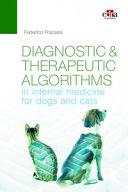Diagnostic and therapeutic algorithms in internal medicine for dogs and cats

Problémově orientovaný přístup (POA) je metoda doporučená College of Internal Medicine k řešení lékařských otázek a problémů. Odtud vznikla myšlenka vytvořit knihu založenou na algoritmech zabývajících se hlavními klinickými a laboratorními klinickými abnormalitami psů a koček s využitím inovativní perspektivy. Každá z 85 kapitol začíná krátkým úvodem, který obsahuje základní patofyziologické a klasifikační informace. Pomocí každého algoritmu je lékař krok za krokem veden postupným prováděním diagnostických vyšetření, stanovením diagnózy a nastavením léčby. V této knize byly zahrnuty dva užitečné a inovativní aspekty: barevné kódy a odkazy na další informace v rámci algoritmu. Žlutá barva označuje diagnostickou cestu, červená diagnózu a modrá je terapie. To umožňuje, aby byl veterinární lékař proveden diagnostickým labyrintem a zvolil nejvhodnější terapii. Uvnitř červených rámečků lze rychle identifikovat seznam diferenciálních diagnóz pro každý problém. Podle žlutých rámečků lze pochopit, jak stanovit správnou diagnózu a optimalizovat diagnostický protokol. Navíc obsáhlé poznámky, spojené s algoritmy pomocí odkazů, poskytují další podrobnosti týkající se konkrétního diagnostického vyšetření, onemocnění nebo doporučené terapie. S touto knihu je léčba psů a koček jasná a přehledná. Na konci každé kapitoly je uveden i seznam další doporučené literatury.
Autor: Federico Fracassi
| Nakladatel | Edra Publishing |
|---|---|
| ISBN | 9781957260211 |
| Vydání | 2022 |
| Vazba | brožovaná, mírně obarvené listy sleva 10% |
| Počet stran | 340 |
The problem-oriented approach (POA) is the method recommended by the College of Internal Medicine to address and resolve medical questions and problems. Hence the idea of creating a book based on algorithms dealing with the main clinical and laboratory canine and feline clinical abnormalities, using an innovative perspective. Each of the 85 chapters begins with a short introduction which includes the basic pathophysiological and classification information. By means of each algorithm, the clinician is guided, step by step, in carrying out diagnostic investigations in a sequential manner, reaching a diagnosis, and setting up treatment. In this book, two useful and innovative aspects were included: color codes and links for additional information within the algorithm. Yellow indicates the diagnostic path, red the diagnosis, and blue is the therapy; this allows the veterinarian to be guided through the diagnostic labyrinth in order to reach the most appropriate therapy. Inside the red boxes, the list of differential diagnoses for each problem can quickly be identified. By following the yellow boxes, one can understand how to reach these diagnoses and optimize the diagnostic protocol. Moreover, comprehensive notes, linked to the algorithms by references, give more details regarding a specific diagnostic investigation, a particular disease, or the therapy recommended.
| Abdominal effusion | 1 |
| Abdominal enlargement | 5 |
| Acid-base anomalies: acidosis | 9 |
| Acid-base anomalies: alkalemia | 13 |
| Acute dyspnea | 17 |
| Adrenal mass | 21 |
| Alopecia in cats | 25 |
| Alopecia in dogs | 29 |
| Anemia: non-regenerative | 33 |
| Anemia: regenerative | 37 |
| Anorexia/decreased appetite | 41 |
| Arrhythmya: supraventricular tachycardias | 45 |
| Arrhythmya: ventricular tachycardias | 49 |
| Ataxia | 53 |
| Azotemia | 57 |
| Bleeding | 61 |
| Blindness | 65 |
| Bradyarrythmias | 69 |
| Cough | 73 |
| Cyanosis | 77 |
| Diarrhea: acute | 81 |
| Diarrhea: chronic | 85 |
| Dysphagia | 89 |
| Epileptic seizures | 93 |
| Equilibrium disorders | 97 |
| Erythrocytosis | 101 |
| Exercise intolerance | 105 |
| Failure to grow | 109 |
| Fever/hyperthermia | 113 |
| Gait abnormalities | 117 |
| Generalized lymphadenomegaly | 121 |
| Heart murmur | 125 |
| Hematemesis | 129 |
| Hematuria | 133 |
| Hypercalcemia | 137 |
| Hyperglobulinemia | 141 |
| Hyperglycemia | 145 |
| Hyperkalemia | 149 |
| Hyperlipidemia | 153 |
| Hypernatremia | 157 |
| Hypertension | 161 |
| Hypoalbuminemia | 165 |
| Hypocalcemia | 169 |
| Hypoglycemia | 173 |
| Hypokalemia | 177 |
| Hyponatremia | 181 |
| Jaundice | 185 |
| Joint pain/joint swelling | 189 |
| Lameness | 193 |
| Leukocytosis | 197 |
| Leukopenia | 201 |
| Low serum T4 concentration | 205 |
| Magnesium disorders | 209 |
| Melena/hematochezia | 213 |
| Muscle wasting | 217 |
| Nasal discharge | 221 |
| Oliguria/anuria | 225 |
| Pain | 229 |
| Paraplegia/tetraplegia | 233 |
| Pericardial effusion | 237 |
| Peripheral edema | 241 |
| Petechiae/ecchymosis | 245 |
| Pigmenturia | 249 |
| Pleural effusion | 253 |
| Pollakiuria/stranguria | 257 |
| Polyphagia | 261 |
| Polyuria/polydipsia | 265 |
| Prostatomegaly | 269 |
| Proteinuria | 273 |
| Pruritus: cats | 277 |
| Pruritus: dogs | 281 |
| Pulmonary hypertension | 285 |
| Regurgitation | 289 |
| Shock | 293 |
| Sialorrhea | 297 |
| Stomatitis: cats | 301 |
| Stomatitis: dogs | 305 |
| Tenesmus/constipation | 309 |
| Thrombocytopenia | 313 |
| Transient loss of consciousness | 317 |
| Urinary incontinence and retention | 321 |
| Vomiting | 325 |
| Vulvar discharge | 329 |
| Weight gain | 333 |
| Weight loss | 337 |